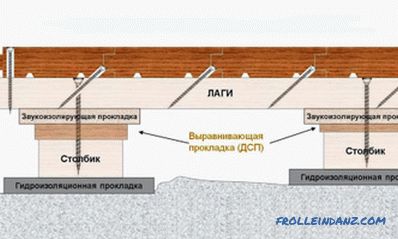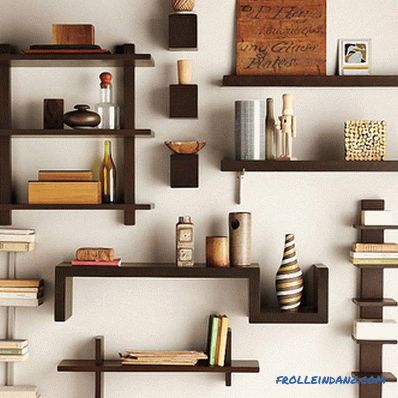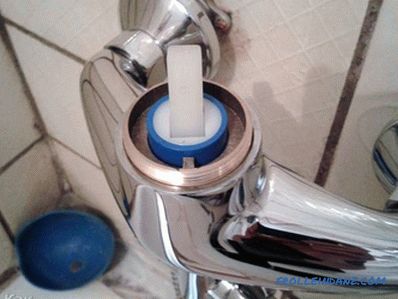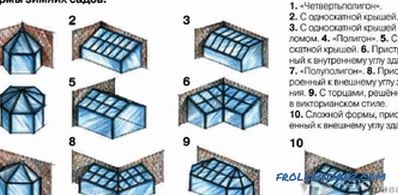Over the course of several years, infrared-type heaters, so in demand today, have become a commodity available to almost everyone. These devices are produced in many European countries, as well as in China and Russia. Buying a heater, of course, I want it to not break and for many years pleased with the heat. We will try to figure out where and how to choose infrared heaters, based on their design features. To do this, we consider in detail how these devices work and how they work, as well as the criteria for their selection.
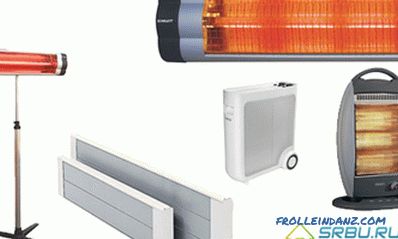
Features of the design and principle of operation of the infrared heater
These devices differ from convectors radically - they heat not the air at all, but the objects in the room including floor and walls. In general, an infrared heater can be compared with a room sun - its radiation, like sunlight, penetrates the air, without warming it at all. But as soon as the beam reaches an object that does not transmit light, it immediately absorbs it, naturally heating up at the same time.
Infrared waves are long - they are perceived by our skin as heat emanating from the sun's rays. We feel it, but we can never see. And these rays warm us, regardless of winds and drafts - they are not at all a hindrance to them. Similarly, they are not afraid of drafts and infrared heaters used in everyday life, because the wavelength of their radiation is similar to the wavelength of the IR spectrum of the Sun.
No convector can heat a room instantly - after all, when it is working, there is a constant upward movement of warm air. That is, first of all, the space in the ceiling is heated, and we are at the bottom, and until the air masses (warm and cold) are mixed, it takes a long time. So you have to freeze all this time, waiting for a comfortable temperature in the room.

Displacement of air masses during convection.
In the case of infrared heaters, everything is different - we start to feel the heat from them immediately after turning on the device, but this heat is not felt in the whole room, but locally, ie, only in the place where radiation.

The principle of heating with an infrared heater.
Inside the device there are no particularly ingenious elements. In the steel case, on which a strong powder paint is applied, there is a reflector made of aluminum. On this reflector is installed the main structural element - heating. There are 4 types of these elements: halogen, carbon, ceramic and tubular (it is called Ten).
Also, each infrared heater has a thermostat to adjust the temperature and a sensor that turns off the device when it overheats. If the device is intended to be installed on the floor, it must also be equipped with a tipping sensor.
Tips for choosing an infrared heater
Design - ceiling, wall or floor?
So, how to choose infrared heaters for the home and which version would be preferable? It depends on the size of the room and on the conditions of use of the device. To begin with, we will determine whether we need a stationary device, or the device is supposed to be moved from room to room. Mobile heaters are smaller and have a small capacity, while stationary ones can be wall-mounted, ceiling-mounted and baseboards.
In general, the most convenient type of devices are ceiling-mounted infrared heaters. They will not take too much space, and their radiation range is quite extensive. There are models mounted in a suspended ceiling - recessed, and there are also those that are attached to a regular ceiling with special brackets - suspended. The distance to the surface of the case from the ceiling is about 5 centimeters.
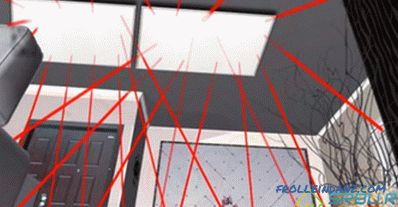
The principle of dispersion of rays from an infrared heater placed on the ceiling.
Low-power and not so effective floor-type heaters meet more obstacles on the way of their radiation than ceiling ones. If you choose one of them, then it is better to focus on models with carbon or tubular heating element. Ceramic heater is not so long, so it is not very suitable. A halogen heating element that emits short waves, which can have a negative effect on a person, is completely unacceptable, since long-wave radiation is necessary for normal operation of this device.
Heaters mounted on the wall must have some distance from the floor surface. If there are kids in the family, then the installation height of the heater is made so that children do not reach the working appliance. If you need to put a heater under the window, choose a model with a plinth execution - it will fit perfectly under the window opening.
A little about the wavelength and temperature of heating
The heating elements located inside the IR heaters can have different radiated wavelengths and different heating temperatures. They are as follows:
Emitters emitting long (ranging from 5.6 to 100 microns) waves. Their working temperature ranges from 100 to 600 degrees, they can be used both in homes, and in offices, and in industrial premises, the ceilings in which are not higher than three meters. However, the apartment has plenty of heater with a working temperature up to 120 degrees.
Medium waves (with a length of 2.5 to 5.6 microns) emit heating elements, basking more strongly - from 600 to 1000 degrees. In this case, the ceiling in the room should be from 3 to 6 meters. This could be, for example, a private house or an administrative building.
Short waves (from 0.74 to 2.5 microns) emit heating elements operating at temperatures from 100 degrees. There is already the required ceiling height - from 6 to 8 meters. Such ceilings can be in the factory or factory floor. In addition, heaters of this type can be used on the street. At home, we do not recommend using them.
Selecting the type of heating element
When deciding on which infrared heater to choose, it must be borne in mind that they differ primarily in the shell in which the element radiating waves is placed. This shell can be made of metal, ceramic or quartz.
The halogen heating element is a halogen lamp that radiates in the infrared range. Inside the lamp is a filament made of tungsten or carbon fiber. When the filament is heated, infrared energy is released and transferred to the tube of the lamp. All halogen lamps emit a golden light that can irritate the eyes; to combat this, some manufacturers cover the lamp with a special compound. But the main disadvantage of this heating element is that the halogen heating element emits short waves, and they can have a negative impact on humans. Therefore, in our opinion, it is better to abandon IR heaters equipped with such a heating element.
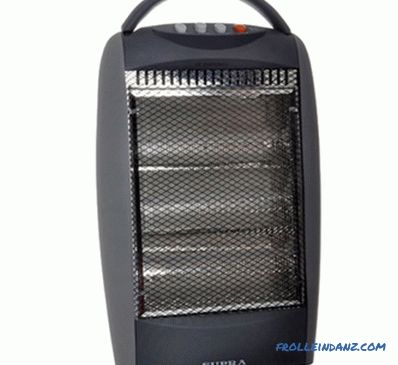
IR heater with a halogen heating element.
Carbon heater element - made in the form of a tube of quartz. Inside it created a vacuum in which there is a carbon (carbon) helix. The advantages of such an element are very fast heating, as well as the fact that its efficiency exceeds the efficiency of a heated metal plate. However, there are also disadvantages: they serve for only about two years, and they consume a lot of electricity — from one to two and a half kilowatts. They also glow reddish light irritating eyes. Also, do not use them asthmatics and allergies. In short, this type of heater is suitable only for short-term operation - it is harmful to use them for a long time.
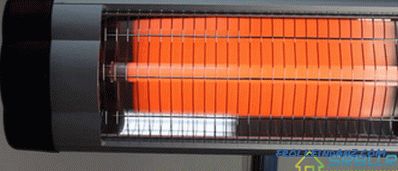
IR heater with carbon fiber heating element.
The heating element with a ceramic shell is perfectly protected, so it does not glow in the process. And this element is not less than three years, only its price is higher than that of quartz. But it is quite economical, and its power consumption range is from 50 to 2000 watts. This difference is due to structural features. Despite the fact that such heating elements do not heat up and cool down very quickly, they are often used in medical institutions and saunas - after all, they are very durable.
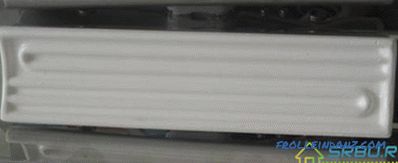
IR ceramic heating element.
A tubular (mikatermichesky) metal element resembles a ceramic element by design, but costs more. Such heaters work well, they are quite reliable and convenient in everyday life. If you are not annoyed by a small crackle when working, you can opt for a similar device. And it is cracking because the coefficients of thermal expansion of the steel helix and aluminum body are different. Nothing wrong with that. Choosing a heater of this type, check what characteristics the heating element, emitter, housing, foil and insulator has.
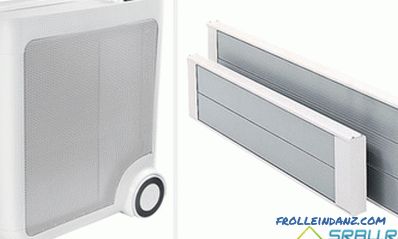
IR heaters with a tubular heating element encased in aluminum.
Questions to ask when buying an infrared heater:
- When deciding how to choose the right infrared heater, you should first ask the thickness of the anodizing layer on the plate emitting infrared waves. If it is not less than 25 microns thick, then successful work is guaranteed for 20 years. If this layer is thinner, then in three years it will be necessary to say goodbye to the heater - it will burn.It is a pity that visually this parameter cannot be checked - when buying a device, you have to rely only on the honesty of the seller.
- The material of the heating element also matters. If it is ferrous metal, then where it is wet (for example, in a bathroom or a sauna), the heater cannot be used. If used stainless steel, then it is much better.
- The emitter foil thickness must be at least 120 microns. If the foil is thinner, then instead of heating the room, the beams will waste the ceiling. It is easy to check the foil thickness - push it with a ballpoint pen. If the foil hesitates or holes, it means that it is not very high quality, no thicker than 100 microns. And at 120 microns, the hole will not be made.
What power is optimal for an infrared heater
For 10 square meters of a room, as a rule, a power of 1 kilowatt (1000 W) is needed. But it is better to purchase a heater with a power reserve (especially if there is no other heat source). After all, you have to take into account the loss of heat through the walls, floors and windows. When the heater is used as an addition to the existing heating system, power is calculated in relation to the conditions of its operation. Here we must also keep in mind the heat loss.
In stores you can find heaters with a total power of 300 watts. They are very convenient to use where you need to quickly and briefly warm the room, for example, a basement or garage. Such devices will not cause much harm, so they may well work in close proximity to people.
If you need to choose infrared heaters to give, keep in mind that summer houses do not need a large heating temperature - it will be enough to raise the temperature in it only by a few degrees. Therefore, it is quite possible to choose a heater at the rate of 60-80 watts per square meter. If it is very cold, these numbers will have to be corrected.
About the insulator
So that the heater body is not heated above 95 degrees, it has an insulator. They are of various types, of which the basalt insulator is considered the best and safest. Especially good if there are no additives in it. After all, these additives can harm human health - they are a source of toxic formaldehyde when heated. The best option would be when a heat insulator is allowed to be used in the food industry - this should be marked in the hygienic certificate (the seller must show it).
How the heater case should look like
The device case should be made of a good quality material - this will allow the heater to serve its owners for a long time. Previously, the material for its manufacture was only steel, but now there are cases made of aluminum. They are more beautiful and modern-looking, but steel cases, of course, more reliable. Looking around the device, look at the case from the inside - there is usually no paint on it, which is quite natural. But the presence of rust traces should alert you. This means that rust will gradually come out on the outside, which is not only ugly, but will also shorten the life of the device.
Choosing a manufacturer
As a rule, we want to purchase a product of this brand that has shown itself in the most favorable light. Of course, you can buy goods from Europe, only it will cost dearly. In addition, it must be borne in mind that almost all large firms from Europe have factories in China, where the cheapest labor is. Gradually, they begin to take parts there too. Due to this, there is a loss of quality. Therefore, when choosing a manufacturer, pay attention to the country of manufacture.
Additional options
It will not be superfluous if the heater has:
- a thermostat is built in to maintain a constant temperature;
- overheating protection sensor;
- for desktops it is desirable to have a sensor for protection against overturning;
- remote control, ceiling models are usually supplied with it, others have it depends on the model.
How to use an infrared heater
The easiest way to take care of ceiling-mounted devices is to periodically brush away dust, that's all. As for models of wall and floor type, the main rule is not to cover them from above. Their faceplate must be located not less than a meter away from the sockets (which must be grounded) and any objects in the room. Where humidity is high, use devices with a protection class not lower than IP24.
Infrared radiation is not harmful to humans. It can even be said that it improves health. That's just under direct rays for a long time should not be - you can get, like the sun, heat stroke.And another thing: if you warm a room with a heater with a capacity of 150 watts per square meter, you can not only weaken the immune system, but also damage the structure of protein molecules. It is best to use instruments with a capacity of 60 to 100 watts per square meter.
Do not buy short wave heaters - these waves can penetrate the body. Long waves are not dangerous, but such heaters must be strictly regulated in height, since the radiation of these waves is the more intense the smaller the distance to the irradiation area. Be sure to monitor your health when using IC heaters. If you feel uncomfortable, better reduce the radiation power. The rule is this: several low-power infrared heaters are better, safer and more efficient than a single, but powerful heater.
Table of technical characteristics and main selection criteria for infrared heaters
| Parameters | Values | Recommendations |
|---|---|---|
| Power | From 100 to 9000 watts. | It is necessary to take at the rate of 1 m2 - 100 watts. |
| Design | Ceiling; Wall mounted; Floor mounted. | It is best to use if you intend to constantly heat one room. Ceiling warms up better all places of the room. It is convenient to quickly warm up any room locally. |
| Type of heating element | 1. Halogen; 2. Quartz; 3. Ceramic; 4. Tubular (mikatermichesky). | 1. Radiating short waves - not recommended. 2. Glowing with a red color irritating eyes, they are better to choose for short-term use. 3. It has a short service life, it is better to abandon its use in wall and ceiling models. 4. The best option for long-term use, the only negative - a slight crackle, mainly during heating and cooling. |
| Stall Sensors | The availability depends on the model. | Presence in floor models is very desirable. |
| Overheating sensor | Availability depends on the model. | Availability is required if you intend to leave the device unattended for a long time. |
| Thermostat | Availability depends on model. | Better if available - to maintain a constant temperature. |
| Remote Control | Ceiling models are mainly supplied with them. | Availability will be a good plus. |
Video: About infrared heaters
